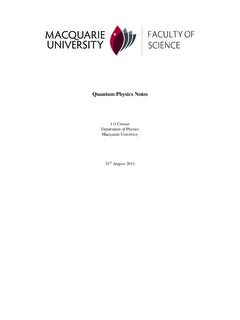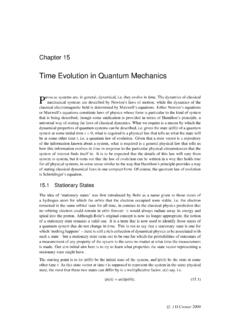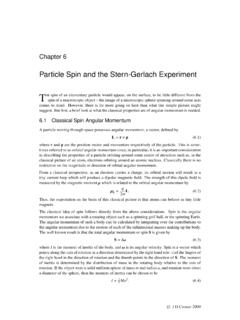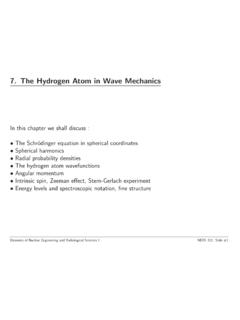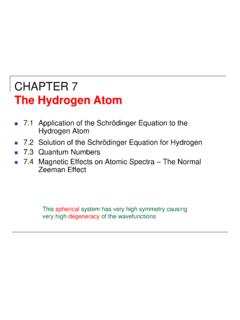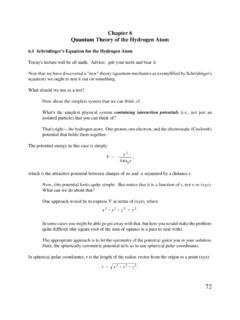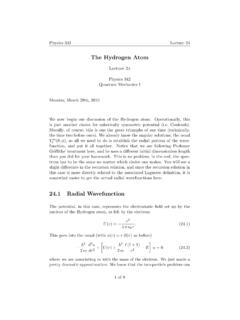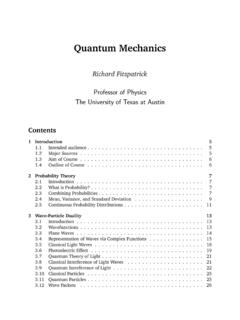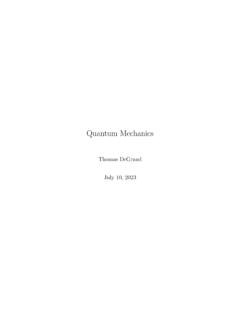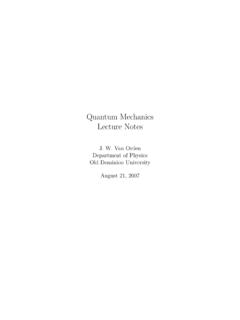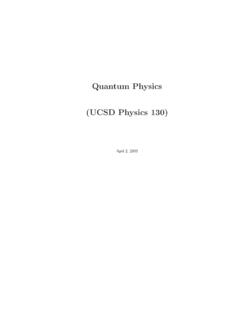Transcription of PHYS201 - Wave Mechanics - Macquarie University
1 PHYS201 Wave MechanicsSemester 1 2009J D C5C357 Ext 8913 Semester 1 2009 PHYS201 Wave Mechanics1 / 86 Quantum Mechanics and Wave Mechanics IQuantum Mechanics arose out of the need to provide explanations for a range ofphysical phenomena that could not be accounted for by classical physics:Black body spectrumSpectra of the elementsphotoelectric effectSpecific heat of solids ..Through the work of Planck, Einstein and others, the idea arose that electromagneticand other forms of energy could be exchanged only in definite quantities (quanta)And through the work of De Broglie the idea arose that matter could exhibit wave was Einstein who proposed that waves (light) could behave like particles (photons).
2 Heisenberg proposed the first successfulquantum theory, but in the terms of themathematics of matrices matrix 1 2009 PHYS201 Wave Mechanics2 / 86 Quantum Mechanics and Wave Mechanics IISchr odinger came up with an equation for the waves predicted by de Broglie, and thatwas the start of wave odinger also showed that his work and that of Heisenberg s were it was Heisenberg, and Born, who first realized that quantum Mechanics was atheory of that Einstein would never accept, even though he helped discover it!Through the work of Dirac, von Neumann, Jordan and others, it was eventually shownthat matrix Mechanics and wave Mechanics were but two forms of a more fundamentaltheory quantum Mechanics is a theory of informationIt is a set of laws about the information that can be gained about the physical will be concerned with wave Mechanics here, the oldest form of 1 2009 PHYS201 Wave Mechanics3 / 86 The Black Body Spectrum IEnvironmentattemperatureT Blackbody attemperatureT!
3 !!!!!!!"1fSObservedspectrumRayleigh-Jean sspectrum1 The first inkling of a new physics lay inunderstanding the origins of the blackbody spectrum:A black body is any object that absorbsall radiation, whatever frequency, that fallson blackbody spectrum is the spectrumof the radiation emitted by the object whenit is in thermal equilibrium with physics predicted theRayleigh-Jeans formula which diverged athigh frequencies the 1 2009 PHYS201 Wave Mechanics4 / 86 The Black Body Spectrum IIPlanck assumed that matter could absorb or emit black body radiation energy offrequencyfin multiples ofhfwherehwas a parameter to be taken to zero at the endof the he got the correct answer for a small but non-zero value ofh.
4 S(f,T)=8 hf3c31exp(hf/kT) 10 34 Joules-secnow known as Planck s 1 2009 PHYS201 Wave Mechanics5 / 86 Einstein s hypothesisEinstein preferred to believe that the formulahfwas a property of the electromagneticfieldPlanck thought it was a property of the atoms in the proposed that light of frequencyfis absorbed or emitted in packets ( ) of energyEwhereE=hfEinstein/Planck formulaSometime later he extended this idea to say that light also had momentum, and that it wasin fact made up of particles now called used this idea to explain the photo-electric effect (in 1905).
5 A first example of wave-particle duality: light, a form of wave motion, havingparticle-like 1 2009 PHYS201 Wave Mechanics6 / 86 The Bohr model of the hydrogen atom I!!!!!"!!!!!!!!"n=1n=2n=3n=4emittedphoto nsRutherford proposed that an atom consisted of asmall positively charged nucleus with electrons inorbit about this to classical EM theory, the orbitingelectrons are accelerating and therefore ought toemit EM electron in a hydrogen atom should spiral into thenucleus in about10 proposed existence of stable orbits (stationary states) of radiusrsuch thatangular momentum=pr=nh2 ,n=1,2,3.
6 Leads to orbits of radiirnand energiesEn:rn=n2 0h2 e2meEn= 1n2mee48 20h2n=1,2,..Semester 1 2009 PHYS201 Wave Mechanics7 / 86 The Bohr model of the hydrogen atom IIBohr radius radius of lowest energy orbit a0=r1= 0h2 e2me= atom emits EM radiation by making a transition between stationary states,emitting a photon of energyhfwherehf=Em En=mee48 20h2(1n2 1m2)Einstein later showed that the the photon had to carry both energyandmomentum henceit behaves very much like a also showed that the time at which a transition will occur and the direction ofemission of the photon was totally first hint of uncaused randomness in atomic s model worked only for hydrogen -like atomsIt failed miserably for heliumIt could not predict the dynamics of physical systemsBut it broke the ice.
7 And a search for classical physics answers was 1 2009 PHYS201 Wave Mechanics8 / 86De Broglie s HypothesisIn 1924 Prince Louis de Broglie asked a philosophical question:If waves can sometimes behave like particles, can particles sometimes exhibitwave-like behaviour?To specify such a wave, need to know itsfrequencyf use Einstein s formulaE=hfwavelength make use of another idea of Einstein sSpecial relativity tells us that the energyEof a zero rest mass particle (such as aphoton) is given in terms of its momentumpbyE=pc= the fact thatf =cgivespc=hc/ which can be solved for = there isno mention in this equation of anything to do with light, de Broglie assumedit would hold for particles of matter as 1 2009 PHYS201 Wave Mechanics9 / 86 Evidence for wave properties of matter50 interferencemaximumofreflectedelectronsn ickelcrystalincidentelectronbeamofenergy 54eV =2 r33 r3In 1926 Davisson and Germer accidently showedthat electrons can be diffracted (Bragg diffraction)
8 Fired beam of electrons at nickel crystal andobserved the scattered observed a diffraction pattern identical to thatobserved when waves (X-rays) were fired at wavelengths of the waves producing thediffraction pattern was identical to that predicted bythe de Broglie P Thompson independently carried out thesame experiment. His father (J J Thompson) hadshown that electrons were particles, the sonshowed that they were de Broglie waves around a circle gives Bohr s quantization conditionn =2 rn= prn=nh2 Semester 1 2009 PHYS201 Wave Mechanics10 / 86 The Wave FunctionAccepting that these waves exist, we can try to learn what they might know the frequency and the wavelength of the wave associated with a particle write down various formulae for waves of givenfand.
9 Usually done in terms of angular frequency and wave numberk: =2 fk=2 / In terms of~=h/2 E=hf=(h/2 )(2 f)andp=h/ =(h/2 )(2 / ) ~ andp=~kSome possibilities for these waves : (x,t)=Acos(kx t)or=Asin(kx t)or=Aei(kx t)or=..But what is doing the waving ?? What are these waves made of ?In absence of any better knowledge give a generic name:the wave 1 2009 PHYS201 Wave Mechanics11 / 86 What can we learn from the wave function? ITo help us understand what might be, let us reverse the if we are given (x,t)=Acos(kx t), what can we learn about the particle?
10 This wave will be moving with aphase velocitygiven byvphase= velocity is the speed of the crests of the ~ =12mv2andp=~k=mvwherevis the velocity of the particle we get:vphase= k=Ep=12mv2mv=12vThat is, the wave is moving with half the speed of its associated 1 2009 PHYS201 Wave Mechanics12 / 86 What can we learn from the wave function? IIThus, from the phase velocity of the wave, we can learn the particles velocity viav= else can we learn Eandp, of what about the position of the particle? (x,t)xvphase!1 This is a wave function of constant amplitude and wavelength.

